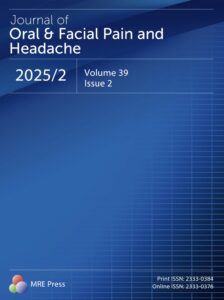Publications

Postural and biomechanical insights in disc displacement with reduction
Authors: Omer Dursun, Abdurrahman Tanhan, Mesut Arslan, Rabia Celikel
Affiliations: Department of Physiotherapy and Rehabilitation, Faculty of Health Sciences, Bitlis Eren University, 13100 Bitlis, Turkey
Journal: Journal of Oral & Facial Pain and Headache - June 2025, Volume 39, Issue 2, Pages 112-123 (DOI: 10.22514/jofph.2025.030)
-
Field & Applications:
- Medical
- Musculoskeletal disorder
- Temporomandibular disorder
- Orofacial muscles
Background: Although the relationship between temporomandibular disorders and posture has been addressed in many studies, a complete consensus has not yet been reached. This study aimed to evaluate global posture, cervical, thoracic and lumbar mobility, and the biomechanical characteristics of muscles in individuals with disc displacement with reduction.
Methods: A total of 70 participants were included in the study, consisting of 37 healthy individuals in the control group and 33 individuals in the study group. The participants included in the study were assessed for temporomandibular joint range of motion, pressure pain threshold in regions related to the temporomandibular disorders (lateral capsule, masticatory muscles and upper trapezius), global posture and thoracic and lumbar spine mobility, cervical posture and mobility, and the biomechanical characteristics (elasticity, stiffness and tone) of the paravertebral muscles, masticatory muscles and upper trapezius. The assessment was conducted using a digital caliper, an analog algometer, a spinal mouse, a universal and modified universal goniometer, and MyotonPRO, respectively.
Results: Cervical and temporomandibular joint range of motion were similar in both groups. The study group showed lower pressure pain threshold overall, except in the left upper trapezius and right anterior temporalis. The biomechanical characteristics (elasticity, stiffness and tone) of the masseter muscle and paravertebral muscles were also comparable, except for reduced elasticity in the left semispinalis muscle. Global posture and mobility (cervical, thoracic and lumbar) were alike in both groups.
Conclusions: This study showed that young adults with disc displacement with reduction largely have similar global posture, mobility (cervical, thoracic and lumbar) and muscle biomechanical characteristics (elasticity, stiffness and tone) compared to healthy individuals. However, their pressure pain threshold, especially at the joint capsule and most measurement points, was lower, except for a few areas.
Keywords: posture, temporomandibular joint disorders, pain threshold
This study demonstrated that young adults with DDwR exhibit global posture, mobility and muscle biomechanical characteristics that are largely similar to those of healthy individuals. Additionally, the study revealed that pressure pain threshold, particularly at the joint capsule and in most other measurement points except for a few, was reduced in young adults with temporomandibular disorders.


